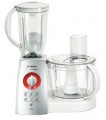Nozzles
— The main bowl. An open capacity designed for kneading dough, whipping cream and mixing masses. The main bowl is included in almost all food processors. It can be made of various materials: plastic, glass, metal, etc.
—
Blender. In this case, it is a bowl narrowed downwards, at the bottom of which there is a bladed knife. Such a device is suitable both for mixing liquids into a homogeneous mass (for example, for making cocktails or batter), and for grinding some solid foods (for example, fruits and vegetables) into a homogeneous puree. The blender is usually installed instead of the main bowl, however, there are devices that allow you to use two bowls at the same time.
—
Food processor. A special capacity for chopping, which is equipped with either a knife for chopping products, or discs for chopping, cutting, French fries. Allows you to cut salads, shred cabbage and perform a number of other operations, depending on the complete nozzles.
—
End-to-end food processor. A special nozzle for installing cutting discs. This accessory allows you to quickly chop vegetables or shred cabbage. Moreover, the final product enters the main bowl (or any other from your kitchen inventory) — there is no separate bowl like in a classic food processor.
—
Meat grinder. The possibility of using the device as a meat grinder
...— for making minced meat, grinding fruits and vegetables. In terms of possibilities, such nozzles are often not inferior to meat grinders made in the form of separate devices.
— Vegetable cutter. A special attachment for cutting vegetables, fruits and mushrooms. Depending on the type, it allows you to cut food: into cubes, slices, sticks, etc. It can be equipped with its own capacity for collecting cuttings.
- Steam cooker. Ability to use the food processor as steam cooker — for steaming food. This method of cooking is considered healthier than classic cooking, it allows you to save a maximum of vitamins and nutrients in the products. Among other things, steaming is often used in the preparation of baby food. Some food processors with this function are originally designed specifically for cooking for children.
— Grinder(for coffee). The grinder with characteristic grinding rods for grinding grains (including coffee beans), oil seed crops, cereals and pulses. It is perfect for making flour. Ussually such attachments have opportunity to adjust the grinding degree.
— Centrifugal juicer. The universal juicer for getting fruit, vegetable and berry juice. Not suitable for citrus fruits (see Citrus juicer). Note that food processor juicers are usually less performant than juicers as separate devices, and therefore are poorly suited for harvesting large amounts of juice.
— Citrus juicer. It is a rotating ledge with a ribbed surface. To get juice, you need to manually put half of the fruit on it with the flesh down and press hard. Due to this procedure, the juice from the flesh is squeezed into the bowl located below, and the peel remains intact.Power
Rated power of the food processor. Most of this power comes from the engine — the rest of the unit consumes very little energy. Usually, the
more power, the higher the productivity of the unit, and the less time it takes to process products.
Note that the optimal power value directly depends on the volume of the bowl (see the relevant paragraph): for example, for a 1.5 kg bowl, at least 300 W is desirable, for a two-kilogram bowl — 400 W, a three-kilogram bowl — at least 700 W. And with the same bowl capacity, a more powerful unit will be more productive, it will work faster and better cope with high loads (for example, a full load). On the other hand, an increase in power affects energy consumption and price.
Number of speeds
The number of fixed speeds of rotation of the attachments provided in the design of the food processor. The more of them, the more accurately you can choose the required speed for each specific mode of operation. It is worth noting that some devices do not have fixed speeds — the control is carried out smoothly (see Stepless speed controller)
Smooth speed control
A control that allows you to smoothly change the speed of rotation of the food processor engine — for more precise adjustment of speed and setting the optimal mode for different products. With stepwise speed control, a situation may arise when a higher speed value is already too high, and a lower speed is not yet enough.
Smooth control avoids such situations.
Section/stand for attachments
The presence in the body of the device of a separate
section for replaceable attachments, or a appliance for storing them directly in the working bowl of the device. Such food processors are more convenient in storage, because they are less bulky, take up less space, and the risk of losing any attachment is reduced.

